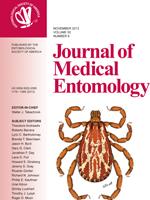Ixodes scapularis Say, 1821 larvae were fed on mice and allowed to molt under laboratory conditions. A liquid chromatography—tandem mass spectrometry-based proteomic study was conducted to identify the type of mammalian proteins present in the derived nymphal ticks at different time intervals after molting. Albumin was present for 85 d; transferrin was present for 29 d; and, more importantly, hemoglobin remained detectable for up to 309 d postmolting. Peptides of actin, keratin, and tubulin are highly similar between mouse and tick, and therefore, unambiguous assignment of these proteins to different species was not possible. Establishing a time line for the persistence of hemoglobin, one of the most abundant blood proteins, at detectable levels in ticks after the bloodmeal and molting advances our efforts to use this protein to identify the host species.
How to translate text using browser tools
1 December 2013
Survival of Host Blood Proteins in Ixodes scapularis (Acari: Ixodidae) Ticks: A Time Course Study
Ünige A. Laskay,
Linda Breci,
Inger-Marie E. Vilcins,
Gabrielle Dietrich,
Alan G. Barbour,
Joseph Piesman,
Vicki H. Wysocki
ACCESS THE FULL ARTICLE
It is not available for individual sale.
This article is only available to subscribers.
It is not available for individual sale.
It is not available for individual sale.

Journal of Medical Entomology
Vol. 50 • No. 6
November 2013
Vol. 50 • No. 6
November 2013
hemoglobin
LC-MS/MS
Mouse
reservoir
vector-borne disease




